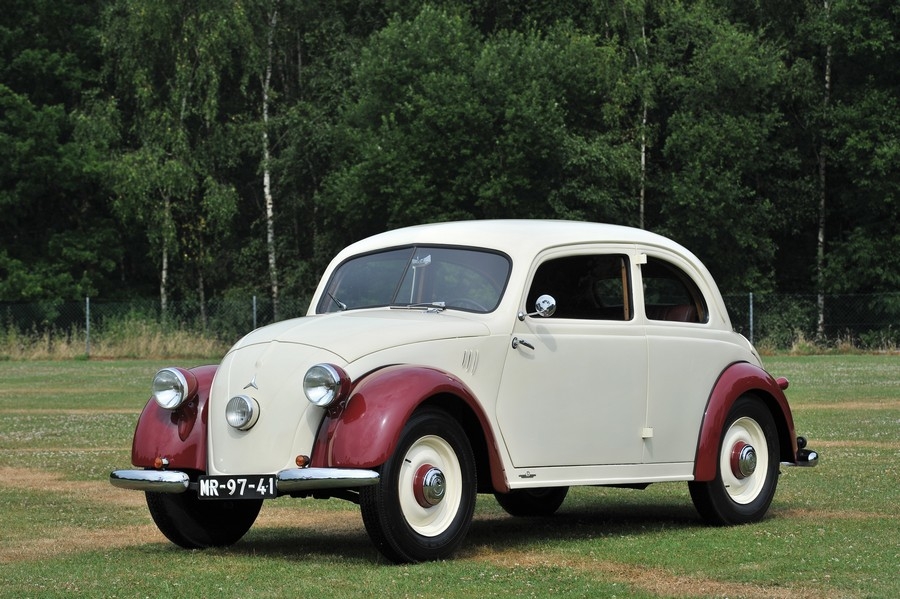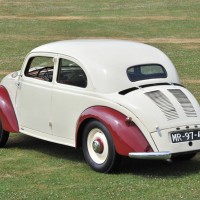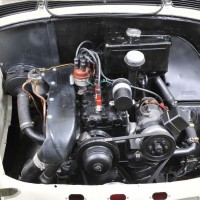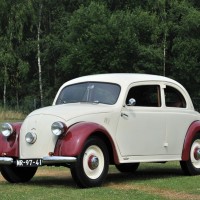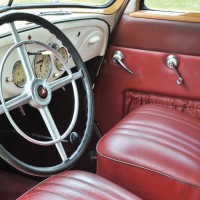Introduced in 1935, the 170H was a more powerful variant of Hans Nibel’s earlier 130H, as it was equipped with an appropriately enlarged engine that now completely occupied the space in the rear of the automobile. It remained in production after World War II, and it joined its earlier sibling in being one of the original German “people’s cars.” Sporting three headlamps, the center being a driving lamp, a rear-mounted engine, and streamlined bodywork, the design, in many ways, recalled the famous Czechoslovakian Tatra. Survivors are rare and hard to find today, particularly pre-war examples, as so few of them survived the conflict.
The two-door saloon offered here is a well-kept older restoration in an elegant combination of cream and wine, with a matching dark red leather interior that is complemented by pebble-finished door sills, which were delivered new through the Daimler-Benz branch in Gleiwitz in February 1936. Chrome has been selectively replated as necessary throughout, and notably, for what was a lower-cost Mercedes-Benz of this period, the interior has an impeccably elegant feel, with clear, round, chrome-edged gauges in a pure white dashboard, which is surrounded by polished wood trim. Despite its diminutive size, the 170H can hold four adult passengers, as it has a full rear seat. Opening the front trunk lid reveals a spare and a small toolkit, which includes a hubcap wrench and hand crank.
Any collection of streamlined pre-war European cars needs a 170H. This 170H has been rarely seen, it is unusual, and it can be imminently used for purring through local roads or around a show field, and the opportunity to buy such a nice example as this is rare indeed.
SCM Analysis
Detailing
| Vehicle: | 1936 Mercedes-Benz 170H Saloon |
| Number Produced: | 1,507 |
| Original List Price: | N/A |
| Tune Up Cost: | $400 |
| Chassis Number Location: | Plate riveted to firewall |
| Engine Number Location: | Stamped on left side of block |
| Website: | http://www.benzlovers.com |
This car, Lot 161, sold for $78,515 (£50,400), including buyer’s premium, at RM Auctions’ London sale on September 8, 2013.
During the 1930s, there was great European interest in rear-engined cars, both as competition vehicles and as solutions for family motoring. The foremost proponents were Hans Ledwinka, chief engineer of Tatra and best known for his T77 and subsequent models, and Ferdinand Porsche and the KdF-Wagen — the forerunner of the Volkswagen Beetle.
These men were champions of the layout and had a lasting influence on cars that followed this pattern in the decades after World War II. Although not very widely known today, Mercedes-Benz was also among this group, as the company introduced the 130H — the letter stood for “Heckmotor,” or rear engine — in 1934, the same year as the Tatra T77 appeared.
Interestingly, Ledwinka’s team worked first on a mid-market family car, the V570, but Tatra decided that the rear-engined concept would likely appeal to a smaller audience, so it would be better to pursue a larger, more powerful and expensive limited-production model in this segment. That model became the T77.
Mercedes, on the other hand, apparently looked at the same information and decided not to risk cutting into their main business in upper-middle and upper-class cars with an experiment in rear-engined cars.
Slow, noisy and expensive
That the rear-engined Mercedes cars from the 1930s didn’t sell in significant numbers is not surprising. Their standard front-engined cars — from the humble 170V up to the mighty 770 — were, if not beautiful, certainly attractive and a bit more than elegant. The “H” models were for the most part ungainly, lacking in body detail, slow — and expensive compared with their front-engined counterparts.
The “H” models were marketed as more “upscale” than their traditional counterparts, but their noisy engines and strange handling endeared them to few who tried them. In addition, while Hans Nibel and his team were undoubtedly very capable engineers, the limits of technical design at their disposal meant that advanced features such as four-wheel independent suspension counted for little against challenges of balance and weight.
Michael Kunz is the manager of the Mercedes-Benz Classic Center USA in Irvine, CA. His shop has restored the only surviving example of the mid-engined 150H Special Roadster and has a 170H Saloon Cabrio-Limousine — the “open sky” version of the saloon with large central soft top. When asked about the driving experience of a rear-engined Mercedes-Benz, Kunz replied “It’s much like a VW Beetle, with the swing axle and all that weight in the back. It can give you a funny feeling in the seat of your pants, but you’d have to be going downhill fast to get into any real trouble.”
That would be no doubt due to the less-than-flashing power of the 38-hp 4-cylinder engine, which delivers a massive 73 lbs/ft of torque and rockets the car to a theoretical maximum speed of 68 mph. Publisher Martin had the opportunity to drive examples of a 1935 130H, the 170H and the 150H Special Roadster a few years ago after they had all been restored at the Mercedes-Benz Classic Center USA. He wrote in The New York Times that the experience was interesting and entertaining, and he ultimately concluded that all three would provide more than adequate transportation in urban areas today.
A rare curiosity
All this brings us to the value this sale represented. This auction featured a remarkable 74 Mercedes-Benz cars from a single collection. The offerings ranged through 80 years of the marque’s history, from a replica 1886 Benz Patent Motorwagen to a 1970 300SEL 6.3, and was crowned with two 1938 540K models. There were three other Heckmotor examples in the sale: a 1935 130H, which realized £47,600 ($74,151); a 1936 130H Cabrio-Limousine, sold for £33,680 ($52,350); and a 1936 150H Cabrio-Limousine which brought £43,680 ($68,050).
By comparison, a front-engined 1939 170V Cabrio-Limousine sold for £31,360 ($48,552). It’s clear that the collector appeal of the Heckmotor cars has increased their value over their more traditional brethren, but it’s also clear that the market for these cars remains largely centered on their curiosity value.
These cars were unwanted when new, so they are therefore scarce today. They are a cul-de-sac in the history of Mercedes-Benz and have no relationship to the cars that followed to the present, once you get past the first 30 KdF V60 Beetle prototypes built by Mercedes.
Based on the catalog descriptions, this example sold for the highest price of all the H models because it had the freshest restoration. It might have actually made more, had the color scheme favored the design a bit better, as the cream body and red fenders emphasized the bulbous thickness of the body, which resembles a VW Beetle that has had air blown up its tailpipe.
These cars work best in dark colors, and an even more flattering paint job is a two-toned scheme that runs along the body character line and separates top from bottom lengthwise.
As a period curiosity, well-restored cosmetically and hopefully equally well-restored mechanically, this 170H has to be considered a reasonable buy. As many of the mechanicals are unique to this model, if it’s intended to be used at all, we have to hope it was completely done, as repairs could prove costly. So, I’d have to call this a qualified well bought and well sold, as these cars trade in a thin market, and a good one is hard to find. ?
(Introductory description courtesy of RM Auctions.)
